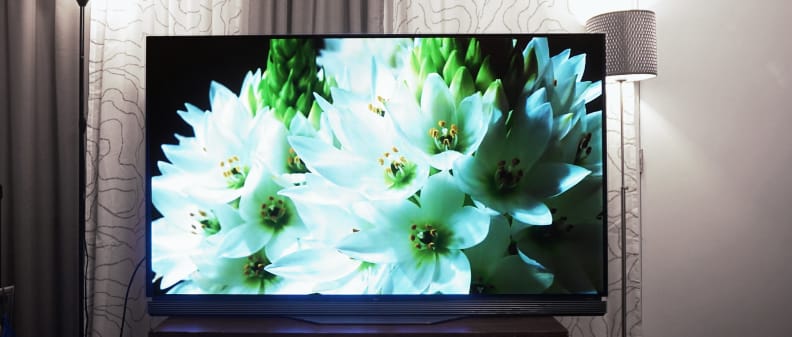Dolby Says The "HDR Format War" Doesn't Exist
No need to choose a side—HDR10 and Dolby Vision can co-exist.
 Credit:
Reviewed.com / Lee Neikirk
Credit:
Reviewed.com / Lee Neikirk
Products are chosen independently by our editors. Purchases made through our links may earn us a commission.
{{ amazon name="Mad Max: Fury Road [4K Ultra HD + Blu-ray + Digital HD]", asin="B01BHKO34U", align="right" }}
High Dynamic Range (or HDR) is the next big thing in TV. Promising tons of contrast, oodles more color, and (of course) 4K/UHD resolution, High Dynamic Range is not only the next best way to sell more TVs—it's a legitimately awesome improvement over "standard dynamic range" (i.e. what we've been stuck with since the '50s.)
Right now, HDR exists in two formats: the "open" HDR10 standard and the "closed" Dolby Vision standard. This means TV manufacturers have to pay a licensing fee to make a TV that's Dolby Vision-compatible, while HDR10 is available to everyone. Naturally, tech journalists (myself included) immediately jumped at the idea of a new "format war" a la Betamax vs. VHS or Blu-ray vs. HD-DVD. Just last month, a piece I wrote up made its way to USA Today with the headline "the new format war."
Quick to respond, Dolby's SVP of Business Giles Baker published a statement to the tune of "don't worry, you really don't need to choose a side." Citing an insightful white paper by imaging expert Chris Chinnock—which you can download for free—Baker is certain that HDR10 and Dolby Vision can "peacefully co-exist" within the constantly changing and cutthroat TV market.
I spoke with Baker over the phone last week to pinpoint exactly why he thinks there's really no competition between HDR10 and Dolby Vision. Baker conceded that a format war might be an "overblown statement" as it stands, as the argument for the formats competing almost entirely hinges on the cost of implementing Dolby Vision in the first place. Here's a breakdown of our conversation:
• HDR is in "the early phase of a new kind of experience," so rumblings about a format war are understandable
• Dolby Vision mastering contains information and possibilities current TVs can't even display yet
• In the meantime, HDR10 may be better for overall distribution and format awareness
• All Dolby Vision TVs will allow HDR10 playback to guarantee the best HDR experience regardless of format
• Providers like Netflix and Amazon always deliver the Dolby Vision HDR format over HDR10 if both are available
• It's about $2–$3 per unit to make a TV compatible with the Dolby Vision format
• HDR10 is easier to implement but uses a lower-quality tone mapping engine than Dolby Vision
• Dolby Vision is already future-proofed through multiple iterations of HDR10
{{ amazon name="LG Electronics 55UH7700 55-Inch 4K Ultra HD Smart LED TV (2016 Model)", asin="B01C9CZEW0", align="right" }}
While it's understandable that Baker would tout the advantages of Dolby Vision over HDR10, he never outright said he thinks the open format is redundant. Because it's a simpler version of HDR, HDR10 wields a "simpler baseline" for creating devices that "check the box" as HDR-compatible. Basically, HDR10 is easier to get out into the world.
Essentially, getting widespread adoption of HDR TVs, AV receivers, and Blu-ray players via HDR10 is advantageous to everyone who is interested in the adoption of High Dynamic Range, and that's what HDR10 is doing. The decoding/playback system "can be implemented by anybody, which ensures the widest availability," says Baker.
However, Baker did caution that Dolby Vision—which currently uses Dolby's super high-performance reference monitors to master HDR content to specifications (such as 12-bit color information, 4,000 nits reference brightness, and 100% or more of the DCI-P3 color space)—tends to tone map better on more affordable TVs. We saw this ourselves during a comparison of Mad Max: Fury Road in HDR10 and Dolby Vision using the LG B6 OLED, which plays both formats.

If Dolby Vision was the only HDR format available, its higher mastering and stricter decoding requirements would make for much less availability in terms of TVs per volume that can play some kind of HDR, as well as HDR-ready disc players and AV receivers that can pass HDR metadata properly.
However, without Dolby Vision as an "HDR mastering standard," content would quickly be outpaced by consumer TVs, which are constantly surpassing limitations of brightness and color. This would mean constant upgrades to the HDR10 standard to keep up with display capabilities. With Dolby Vision as a mastering source, content can update in time with the progressing capabilities of consumer TVs.
In fact, according to Baker, the Dolby Vision "volume" based mastering standard is "definitely big enough to accommodate pretty much anything we can imagine." When I asked whether Dolby might ever update the 10,000 nit end-point reference brightness, Baker conceded that "at some point, too much brightness becomes painful." Considering 1000 nits is considered premium for TVs this year, we won't have to worry about hitting the mastering reference any time soon.
There are more HDR10-compatible TVs and disc players than Dolby Vision because it's an easier, cheaper standard to implement. However, Baker confirmed that Dolby is committed to expanding manufacturer partnerships as soon as possible, with an aim to have on-disc Dolby Vision content available by early 2017.
I walked away from the conversation equally convinced that this isn't really a format war or an arms race—it's simply two different options for content creators, manufacturers, and consumers. Think of it like having both premium and unleaded available at the gas station. Both have pros and cons (reflected in cost/performance), and whether you need one or the other really depends on how fast you want to drive. This isn't the post-apocalypse: we can have both.


